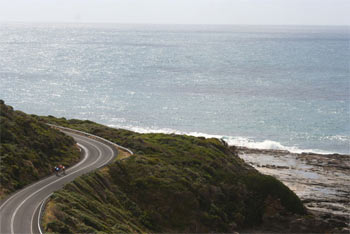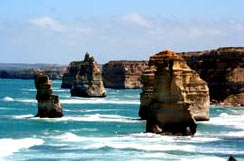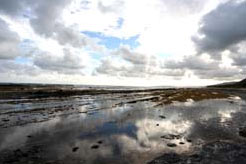
|
Sure enough I’d got the weather right. It was early January, and with the sun dappled sky helping keep things cool for a mid summers day, the temperature was just about high enough to bare short legs. But I got things wrong on the traffic side. Peak holiday season meant somewhere around three times the normal amount of traffic on the roads, but luckily this isn’t the kind or road you rush. With this in mind, I would recommend riding the route outside of January for a more enjoyable experience of this route.
Heading in from Warnambool I was beginning to wonder where the ocean actually was, but not for long. A few kilometres after turning onto the B100 at Allansford, the Great Ocean Road officially begins. The flat desert scenery faded away as the road turned into a long winding garden path, with surrounding vegetation bursting out with enthusiasm and the sky an ever increasing shade of deep blue. Then suddenly I rounded a corner and there it was, the ocean that helped put the great in The Great Ocean Road.
For months I’d been looking forward to this ride – it’s about as pilgrimatic in cycling terms as it gets. I’d heard so much about the beauty of this road, and within seconds of hitting the Victoria coastline I was grinning from ear to ear and quietly whispering, “wow” to myself. The road was built just after the First World War by returning soldiers and spans a 276 kilometre section of coastline between Warnambool and Geelong. The official starting point of the road though is actually the B100 at Allansford with the official ending at Torquay. By bike it makes sense to use the train between Geelong and Warnambool, if you want to make this a one way ride.

|
Hugging the coastline high above the cliffs of Shipwreck Coast, the road heads east, dipping in and out of small bays and then climbing the long and tough drag onto a high rolling plateau to reach the most famous point of the journey: The Twelve Apostles. From the road these stranded ocean towers are not visible, but a short walk takes you to a viewing point. They say nothing prepares you for your first sighting of the Apostles, and I can’t argue with that. These great natural giants of old are totally mesmerising, set in a fragmented shoreline of high cliffs and jagged inlets, deserted sandy coves, all guarded by a line of huge and decaying high pillars.
For me this is what I’d come to see. This ride is as much about the scenery as the cycling, so, happy assuming I’d seen the best of this amazing highway, I pedalled on towards Apollo Bay. But how wrong could I be. The jagged cliffs and towers soon disappeared as the road heads inland to Lavers Hill and Cape Otway. The dessert like oranges turned to lush mountain greens, a long and twisty road climbs for what seems like an eternity, rising high through the beech forests through an Alpine like landscape, as far removed from the earlier section of the route. Huge great meadows peppered with cattle and narrow tree lined side roads take over: real mountain country. I decided to turn right towards Cape Otway Lighthouse, where the road thins and became amazingly tree shrouded. It was probably one of the best ride points of the entire journey, and was enough to lead me to take an extra day out in Apollo Bay to see what lay off the beaten track.
From Cape Otway a long descent leads to Apollo Bay. The green theme continues here; a great bay nestles beneath a mass of rolling green hills, the cliffs long gone, from here on in its deserted beaches and rocky coves. This was also where I came across my first cyclists of the ride, and is also where a certain Phil Anderson (winner of two Commonwealth Games Gold medals and 16 years as a pro rider) lives. The official brochure quotes his favourite ride, an inland route through Sunnyside, so I decided to check it out. A long steep climb through Alpine meadows that turns to dirt, all traffic free, made for a refreshing change of scenery and is definitely recommended.

|
Back to the original plan and with the crisp and golden sun lighting the early waves, I headed towards Cape Patton. The section that stretches from Apollo Bay to Lorne is probably the best and most imposing section by bike. It’s just over 40 kilometres with the road carved into the rocky hillside. You appreciate this even more when you see the aerial picture post cards of the road. Sandy coves, pristine beaches and lush green vegetation mark this section out in total contrast to the earlier desert and cliff scenery. I’m not sure which was the most impressive as they are so different, but both stunning in their own ways.
The ride was nearing the end. As soon as I passed through Lorne the traffic heated up, so time to get my head down and endure the slog for home. With a fantastic ride bagged and a huge great and satisfied tick on the wish list.
When to ride
You can ride this road at any time, but probably February-May and October-December stand out as prime ride times. During this period the weather is pretty good, and the traffic quite reasonable. Avoid peak holiday periods and busy weekends.
The ride
From Warnambool to Geelong is 276 kilometres in total, although if you have the luxury of vehicle support then I would suggest cutting out the section to Allansford, and also consider finishing in Lorne, making it an easy two day route with a stop over in Apollo Bay. The official cycling guide to the route is available free from tourist offices along the route, and is great for general information. It also has profile maps and details of other rides along the route. The suggested itinerary they list takes 4 days for the journey in total. The Lonely Planet Guide to Cycling in Australia also covers the route in detail.
Which direction you ride in is down to personal choice, although many suggested itineraries run from Geelong westwards, I would recommend starting from Warnambool to make the most of the prevailing winds. The route is part of the annual October Melbourne-Warnambool race, one of the longest in the world.
The route often also features as part of the Great Victorian Bike Ride. For details check out www.bv.com.au and www.greatoceanroad.org/cycling
Along the route
There are loads of accommodation options along the route, although they can get booked out at peak times. Warnambool has plenty of options, as does Apollo Bay and Lorne. There are also choices in the smaller towns along the way. For details and listings check out www.greatoceanroad.com. All of the towns along the route have cafes, restaurants and more. Apollo Bay is a busy little seaside town with loads of great eateries, check out Nortigalls. For accommodation and other info check out www.greatoceanroad.com



